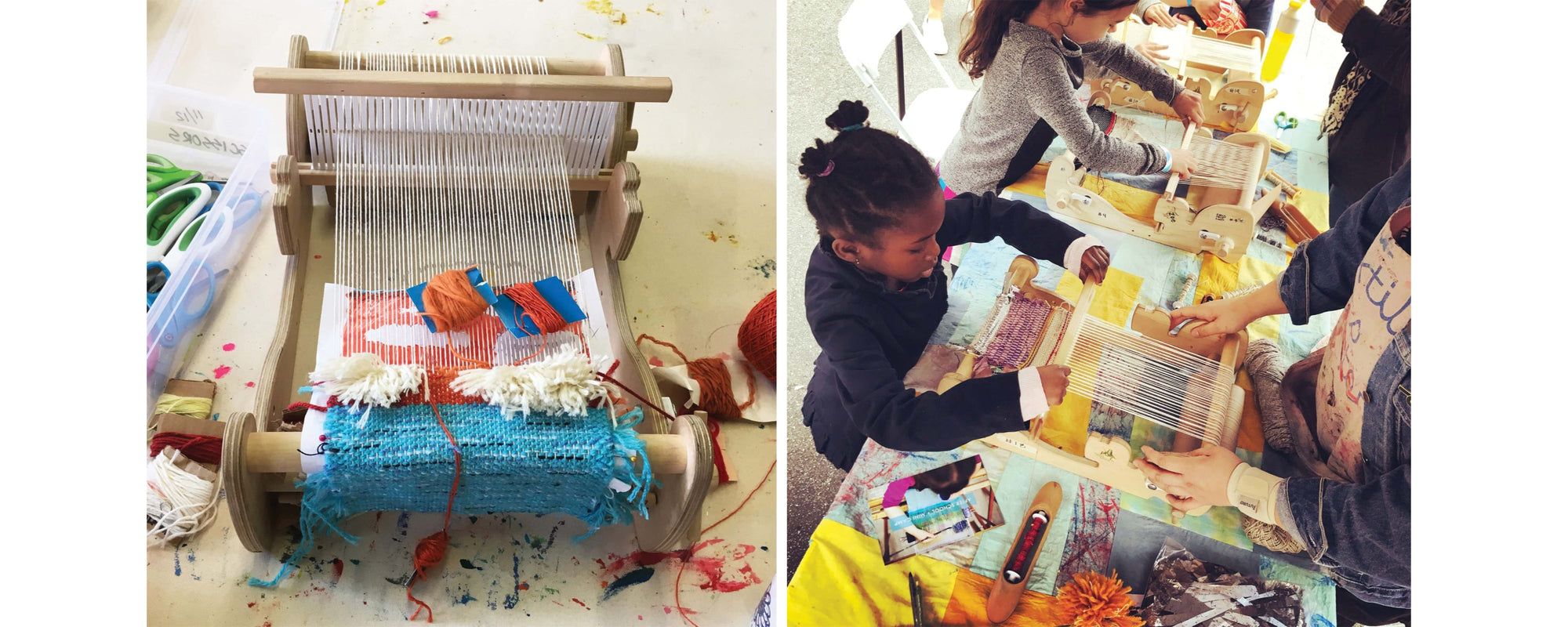By Carrie Miller
I had the pleasure of interviewing Lisa Sikorski, the Director of Youth Programs at the Textile Arts Center in Brooklyn, New York. We first talked before the pandemic and then revisited our conversation last week. In this 2-part interview, she tells us what her program looked like before the pandemic and how they have adapted and succeeded despite it.
Pre-Pandemic
SSC: When did the Youth Program start?
Lisa: The youth program started the same time as TAC. About 10 years ago.
SSC: What programs do you offer?
Lisa: We offer afterschool classes, mini camps, summer camps, and classes for teens. Our curriculum includes weaving, surface design and other textile activities.
Lisa's Tips for Weaving with Kids:
- Focus on process-oriented activities instead of having the same project for each kid.
- Never re-thread the warp. Tie on new warp to old warp and pull through heddles when needed.
- Always use straight draw threading.
- Use a natural color warp such as white carpet warp.
- Try warp painting to teach additional skills and add color interest.
- Make use of fun materials such as roving or top.
- Keep the excitement going by dyeing after the weaving comes off the loom.
- Have a plan for finishing: heat treat to other surface, simple knots, hand/machine sewing.

Keep students engaged with a variety of weft materials.

Warp painting is a great skill that is exciting for students to try.
Lisa's Advice for Starting a Youth Weaving Program:
- Think outside of your training.
- Be playful and experimental.
- Try materials that kids are already familiar with.
- Gather perspectives from weavers and non-weavers to develop an accessible curriculum.
During the Pandemic
SSC: How has the pandemic changed your program?
Lisa: Because it is so serious in NY, the facility is still closed. Before COVID, we had no remote programming; now we are fully remote. The actual subject matter is the same, but we have changed which classes we are able to offer. For example, silk screening is very difficult to teach remotely. Tapestry weaving has been easy to transition to remote learning. We've been able to have some dyeing and surface design. Our students have transitioned to much more experimental subject matter than completed projects.
SSC: What aspects were most difficult to change?
Lisa: Learning to be an organization that ships. Getting a kit together, delivery method, etc. The adult program has expanded because of its online presence. And, kids are participating from afar since many are at grandparents for the summer or their families have chosen to quarantine elsewhere.
SSC: Have you found that most students have adapted to new platforms?
Lisa: Because students have to use Zoom and other online platforms for school, they have been able to adapt well. We had to turn the 5 & 6-year-old program into a parent and child program. Having a child myself has helped with understanding what kids need! Students use how-to videos (such as Schacht's Warping the Cricket Loom) for the basic instruction. Then Zoom calls support the students in solving any problems. Crickets have become our go-to looms for loaning out. Parents and students can warp these much easier than a four-shaft loom and the compact size works in small living spaces.
SSC: What role do you see textile arts and weaving playing in the socially distanced world?
Lisa: In camp and after school programs, Craft Circle allows for chit-chat time during making. This is a way for the kids to be socially engaged with each other while keeping their hands busy. In distance learning, this type of time is lost for most schools. Our programs offer this along with supplementing school work concepts through making. Textile art activities are also relaxing and calming. This is so helpful for kids right now.
SSC: What are your students learning this summer?
Lisa: Summer camp projects include:
- Natural dyeing
- Embroidery
- Tapestry
- Felted Soap
- Oil Printing
- Bead Weaving
- Kumihimo
- Marbling
- Cricket Loom Weaving
- Hand and Machine Quilting
SSC: What would you suggest for youth programs that are trying to adapt?
Lisa: In our neighborhood, the community was there for each other to help in adapting. We assisted each other in working through what success is in this new normal.
- Find your support system.
- Find your truth: what does success look like for you now?
- Experiment to find what projects work on remote platforms for your students.
Lisa develops the curriculum for all of TAC's youth programs. Her background is in metalsmithing. She has been teaching, making wearables, dyeing, and sewing for 20 years. Visit the Textile Art Center website to learn more about their programs.


